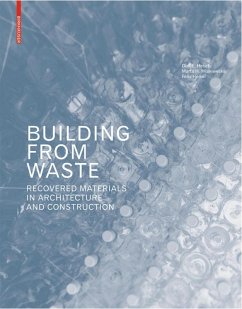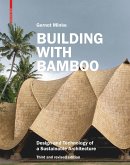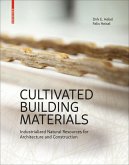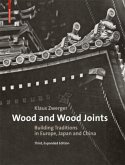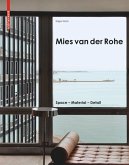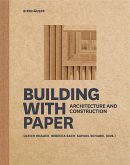”Reduce, Reuse, Recycle, and Recover" is the sustainable guideline that has replaced the ”Take, Make, Waste" attitude of the industrial age. Based on their background at the ETH Zurich and the Future Cities Laboratory in Singapore, the authors provide both a conceptual and practical look into materials and products which use waste as a renewable resource.
This book introduces an inventory of current projects and building elements, ranging from marketed products, among them façade panels made of straw and self-healing concrete, to advanced research and development like newspaper, wood or jeans denim used as isolating fibres. Going beyond the mere recycling aspect of reused materials, it looks into innovative concepts of how materials usually regarded as waste can be processed into new construction elements. The products are organized along the manufacturing processes: densified, reconfigured, transformed, designed and cultivated materials.
A product directory presents all materials and projects in this book according to their functional uses in construction: load-bearing, self-supporting, insulating, waterproofing and finishing products.
"Reduce, Reuse, Recycle, Recover!" ist heute die Leitlinie für nachhaltiges Bauen, die an die Stelle der Wegwerfmentalität der industriellen Moderne getreten ist. Das Autorenteam von der ETH Zürich und dem Future Cities Laboratory in Singapur gibt hier erstmals einen systematischen Überblick über die aus Abfall als erneuerbarem Rohstoff produzierten Baumaterialien und -elemente und über ihre Anwendung in Architektur, Innenraumgestaltung und Produktdesign.
Die Bandbreite der dargestellten Baustoffe reicht von marktgängigen Produkten, wie Fassadepaneele aus Stroh oder selbstheilender Beton, bis hin zu Neuentwicklungen wie Holzbauelemente aus Zeitungspapier oder Isolierfasern aus Jeansdenim. Die Produkte werden auch in ihren Anwendung in gebauten oder prototypischen Projekten gezeigt.
Das zugrunde liegende Konzept, Materialien in zusätzliche Lebenszyklen in der gebauten Umwelt zu überführen, geht über bloßes Recycling weit hinaus und umfasst fünf Gruppen vonProdukten entsprechend ihrer Herstellungs- und Wirkungsweise: Verdichtung, physische Verwandlung, chemische Verwandlung, multifunktionale Gestaltung und biologisch-chemische Wachstumsprozesse.
In einem weiteren Zugang werden die Produkte und Projekte nach ihren Einsatzmöglichkeiten im Tragwerk, als selbsttragende Elemente, für Wärmedämmung und Feuchteschutz sowie im Ausbau gegliedert und dargestellt.
This book introduces an inventory of current projects and building elements, ranging from marketed products, among them façade panels made of straw and self-healing concrete, to advanced research and development like newspaper, wood or jeans denim used as isolating fibres. Going beyond the mere recycling aspect of reused materials, it looks into innovative concepts of how materials usually regarded as waste can be processed into new construction elements. The products are organized along the manufacturing processes: densified, reconfigured, transformed, designed and cultivated materials.
A product directory presents all materials and projects in this book according to their functional uses in construction: load-bearing, self-supporting, insulating, waterproofing and finishing products.
"Reduce, Reuse, Recycle, Recover!" ist heute die Leitlinie für nachhaltiges Bauen, die an die Stelle der Wegwerfmentalität der industriellen Moderne getreten ist. Das Autorenteam von der ETH Zürich und dem Future Cities Laboratory in Singapur gibt hier erstmals einen systematischen Überblick über die aus Abfall als erneuerbarem Rohstoff produzierten Baumaterialien und -elemente und über ihre Anwendung in Architektur, Innenraumgestaltung und Produktdesign.
Die Bandbreite der dargestellten Baustoffe reicht von marktgängigen Produkten, wie Fassadepaneele aus Stroh oder selbstheilender Beton, bis hin zu Neuentwicklungen wie Holzbauelemente aus Zeitungspapier oder Isolierfasern aus Jeansdenim. Die Produkte werden auch in ihren Anwendung in gebauten oder prototypischen Projekten gezeigt.
Das zugrunde liegende Konzept, Materialien in zusätzliche Lebenszyklen in der gebauten Umwelt zu überführen, geht über bloßes Recycling weit hinaus und umfasst fünf Gruppen vonProdukten entsprechend ihrer Herstellungs- und Wirkungsweise: Verdichtung, physische Verwandlung, chemische Verwandlung, multifunktionale Gestaltung und biologisch-chemische Wachstumsprozesse.
In einem weiteren Zugang werden die Produkte und Projekte nach ihren Einsatzmöglichkeiten im Tragwerk, als selbsttragende Elemente, für Wärmedämmung und Feuchteschutz sowie im Ausbau gegliedert und dargestellt.
"Das Autorenteam von der ETH Zürich und dem Future Cities Laboratory in Singapur gibt hier erstmals einen systematischen Überblick über die aus Abfall als erneuerbarem Rohstoff produzierten Baumaterialien und -elemente und über ihre Anwendung in Architektur, Innenraumgestaltung und Produktdesign."
IBOmagazin 2/2015
IBOmagazin 2/2015

